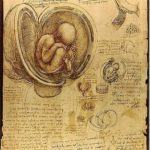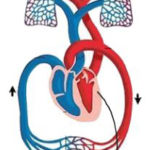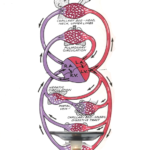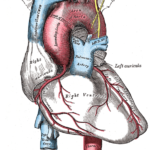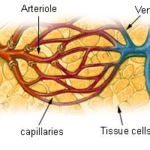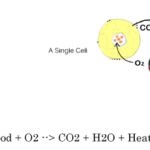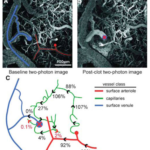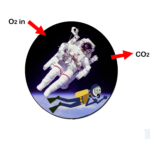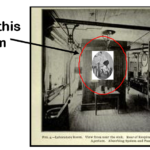Week 1. Visual the Oxygen Delivery System and Aerobic Metabolism
IMPORTANT! Tap or click the image to dismiss or recover the caption.
I purposely use the term oxygen delivery system as opposed to cardiovascular system to make you consider the flow of oxygen within your body rather than blood.
Of course, both blood and oxygen flow together simultaneously in blood vessels and capillaries – but O2 ‘makes metabolism’ by combining with the food you ate in a cell. Blood is just the carrier for fuel and oxygen.
Visualize the Oxygen Delivery System
The gallery of pictures below show the general big picture and the microscopic view of the structures that deliver oxygen as well as the structure of the cells where oxygen is utilized.
IMPORTANT! Tap or click the image to dismiss or recover the captions.
At this point we have two different, primary ways to see how oxygen is used:
Choice 1: In context of VO2 used – that is the amount or volume of O2 used at any moment or over time.
This includes at rest, during any sport or intensity level of exercise, during ‘depressed’ altered states of metabolism (e.g. hibernation, open heart surgery), and of course, how VO2 consumption changes with training and fitness levels.
- Conceiving a Human’s Total Oxygen Consumption shown below in another picture gallery.
Choice 2: In context of fuel substrate used in the cell:
Oxygen cannot be utilized unless it combines with carbon, which is the actual fuel from food, period.
The carbon in fat, carbohydrates or protein combusts like others gaseous fuels to produce CO2 as shown in Lesson One: ‘The Rule of Fire of your workbook, The Physical Rules.
I know this is a big leap in learning both fat and carbohydrates both break down to a ‘final fuel’ made of two carbon atoms – which is essentially vinegar or technically acetic acid. For now just think of carbohydrates and fat as fuel.
However, we will examine later how fat and carbohydrates breakdown to this single ‘final fuel’ which will clarify functional nutrition, how cells really work, and overall refine your perception of ‘healthy’ fats, health, and sports nutrition.
For the next few weeks going forward, we are examining how the body uses oxygen at rest and relative to exercise intensity.
Then we’ll progressively connect the dots on how food as ‘carbon fuel’, health, and performance all tie together.
Oxygen Consumption Visualized – at rest.
All the cells of your body use a tiny amount of oxygen. If you place your body inside a sealed airtight space as the artist did in the plaster of Paris box below – the space you inhabit becomes a single cell.
To an outsider you appear as a single gigantic cell.
Under all the conditions below a grand total Volume of Oxygen (VO2) enters a single space that encapsulates a human. From out of this space a Volume of Carbon Dioxide (VCO2) exits.
When we say “oxygen is consumed”, this means O2 combines with the carbon (fuel) in food to make CO2.
Fuel + VO2 –> VCO2 + H2O + Heat
Later, I’ll show how knowing the volume of O2 consumed and the volume of CO2 produced reveals the percentage of fat and carbohydrates used by the body at rest or during any intensity level of exercise.
SUMMARY:
Aerobic metabolism is a slow form of combustion in cells – including the brain, heart, muscles, liver, kidneys, etc.
The final destination for O2 – which is gas dissolved in the blood – is the mitochondria of cells, where carbon from food reduced to vinegar as the final fuel combines with O2.
The entire cardiovascular system is essentially like a garden hose attached to itself, but with a pump (the heart) attaching each end together.
It takes approximately 70 seconds for blood to return to the heart after freshly oxygenated blood exits the heart.
Blood returning to the heart will contain less dissolved oxygen in it, and progressively lesser as exercise intensity increases – or imagined as the rate of combustion increases.
Exercise = oxidative metabolism ‘speeded up’. Your cells simply make a ‘bigger fire’ as more fuel and O2 get ‘tossed into the firebox’.
It’s vital to realize ‘oxidation’ is the same thing as aerobic metabolism – and is also a double edge sword in that oxidative metabolism is what keeps us alive and breathing, but oxidative damage, which is another form of oxidation within our body, causes damage and inflammation.
We’ll later examine ‘bad’ oxidation… known by these names: the free radical chain reaction, varnishing, polymerization, plasticization. For now, you can imagine ‘bad oxidation’ the same way as making fire:
Oxygen combines with something and alters whatever it combines with, e.g.
O2 + Carbon –> CO2
Aerobic metabolism isn’t the only way oxygen reacts in our bodies.
Recap Week 10 and Overview Week 11, 2017
Recap Week 10
Clarified Butter = Ghee: Because it has been fermented there is negligible lactose (much less than a gram). Lactose intolerant people can ingest 8g and remain unaffected.
Lymph: What is it spatially/anatomically – around the cells, vessels, and nodes?
Match Stick: Look at Week 3 chart: Glycogen Depletion Rates
Billion Year Old Carbon:
Overview Week 11, 2017
O2 consumption is a simple concept. Carbon burns.
Graphing VO2 is even simpler. Move, mover faster – and the graph is essentially a straight line until ‘the fire’ reaches its maximum rate of burning. At this point – no additional power is produced by oxidizing carbon.
On board before audience arrives:
Handout
Plant Respiration & Synergy of Energy Transformation
Props
Matchstick
Candle
Why does the wick burn extremely slowly?
What is actually burning mostly?
What three states of matter – of the main substance burning – do we see simultaneously?
What is the equivalent reaction in your body?
Where does this reaction occur specifically?
What are the reactants and what are the products of the reaction?
What ‘runs out’ in cave or sealed space when we suffocate?
Why would a fast burning explosive kill you by not damaging you physically?
Videos and/or Additional Reading
What burns when you light a candle?
http://home.howstuffworks.com/question267.htm
http://thehappyscientist.com/science-experiment/whats-burning
Thermodynamics of Weight Loss:
Thermodynamics of Weight Loss Diets
Lulu Hunt Peters: Diet & Health
Death by instantaneous removal of oxygen from air:
More on oxygen:
Molecules, magic, and forgetful fruitflies; the supernatural science of medical gas research

